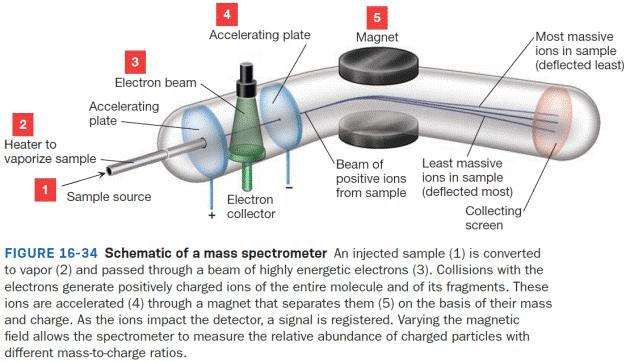
Interpretation:
In Figure 16-34, a line to represent the path of an ion that is too light to reach the detector is to be drawn and labeled as “too light.” The same is to be done for an ion that is too massive to reach the detector and to be labeled as “too massive.”

Concept introduction:
Mass spectrometry provides insight into the mass of a molecule and the fragments that compose it. Unlike spectroscopy, however, mass spectrometry does not involve
Once vaporized, these gaseous molecules, M (g), drift through a beam of fast moving electrons. When an electron from that beam impacts a molecule of M (g), an electron from M (g) is knocked off, producing a gaseous species that has one fewer electron and therefore has a positive charge. The process of producing this molecular ion, M+ (g), is called electron impact ionization and can be represented by Equation 16-6.
A charged species like M+ (g) can be guided into a detector through a curved tube using a magnetic field to bend the ion’s path. The extent that a given ion’s path is bent depends on the strength of the magnetic field that is applied and the mass-to-charge ratio of the particle, represented as m/z. If the magnetic field strength is held fixed, then only ions of a specific value of m/z can reach the detector. Ions with m/z different from that value will collide with the wall of the tube and will be destroyed before reaching the detector; those that are too light will be deflected too much whereas those that are too massive will not be deflected enough. If multiple ions with different m/z values are present, then the magnetic field strength can be adjusted to allow the various ions to be detected. The detector itself is designed to keep track of the number of charged species that collide with it; this number is translated into what is called the relative abundance of the ion. The greater the number of charged species detected, the greater the ion’s relative abundance. If multiple ions are produced with different values of m/z, then the magnetic field strength can be scanned to determine the relative abundance at each m/z.
Want to see the full answer?
Check out a sample textbook solution
Chapter 16 Solutions
Organic Chemistry: Principles And Mechanisms: Study Guide/solutions Manual (second)
- Calculate the reaction quotient for the reaction:NaOH (s) ⇌ Na+ (aq)+ OH- (aq) + 44.4 kJ [Na+] = 4.22 M [OH-] = 6.41 Marrow_forwardGiven the following concentrations for a system, calculate the value for the reaction quotient: Cl2(g)+ CS2(g) ⇌ CCl4(g)+ S2Cl2(g) Cl2 = 31.1 atm CS2 = 91.2 atm CCl4 = 2.12 atm S2Cl2 = 10.4 atmarrow_forwardMatch each chemical or item with the proper disposal or cleanup mwthod, Not all disposal and cleanup methods will be labeled. Metal sheets C, calcium, choroide solutions part A, damp metal pieces Part B, volumetric flask part A. a.Return to correct lables”drying out breaker. Place used items in the drawer.: Rinse with deionized water, dry as best you can, return to instructor. Return used material to the instructor.: Pour down the sink with planty of running water.: f.Pour into aqueous waste container. g.Places used items in garbage.arrow_forward
- Write the equilibrium constant expression for the following reaction: HNO2(aq) + H2O(l) ⇌ H3O+(aq) + NO2-(aq)arrow_forwardWrite the reaction quotient for: Pb2+(aq) + 2 Cl- (aq) ⇌ PbCl2(s)arrow_forwardWrite the equilibrium constant expression for the following system at equilibrium: I2 (g) ⇌ 2 I (g)arrow_forward
 Principles of Instrumental AnalysisChemistryISBN:9781305577213Author:Douglas A. Skoog, F. James Holler, Stanley R. CrouchPublisher:Cengage Learning
Principles of Instrumental AnalysisChemistryISBN:9781305577213Author:Douglas A. Skoog, F. James Holler, Stanley R. CrouchPublisher:Cengage Learning ChemistryChemistryISBN:9781305957404Author:Steven S. Zumdahl, Susan A. Zumdahl, Donald J. DeCostePublisher:Cengage Learning
ChemistryChemistryISBN:9781305957404Author:Steven S. Zumdahl, Susan A. Zumdahl, Donald J. DeCostePublisher:Cengage Learning Chemistry: An Atoms First ApproachChemistryISBN:9781305079243Author:Steven S. Zumdahl, Susan A. ZumdahlPublisher:Cengage Learning
Chemistry: An Atoms First ApproachChemistryISBN:9781305079243Author:Steven S. Zumdahl, Susan A. ZumdahlPublisher:Cengage Learning
 Introduction to General, Organic and BiochemistryChemistryISBN:9781285869759Author:Frederick A. Bettelheim, William H. Brown, Mary K. Campbell, Shawn O. Farrell, Omar TorresPublisher:Cengage Learning
Introduction to General, Organic and BiochemistryChemistryISBN:9781285869759Author:Frederick A. Bettelheim, William H. Brown, Mary K. Campbell, Shawn O. Farrell, Omar TorresPublisher:Cengage Learning Chemistry: Principles and PracticeChemistryISBN:9780534420123Author:Daniel L. Reger, Scott R. Goode, David W. Ball, Edward MercerPublisher:Cengage Learning
Chemistry: Principles and PracticeChemistryISBN:9780534420123Author:Daniel L. Reger, Scott R. Goode, David W. Ball, Edward MercerPublisher:Cengage Learning





